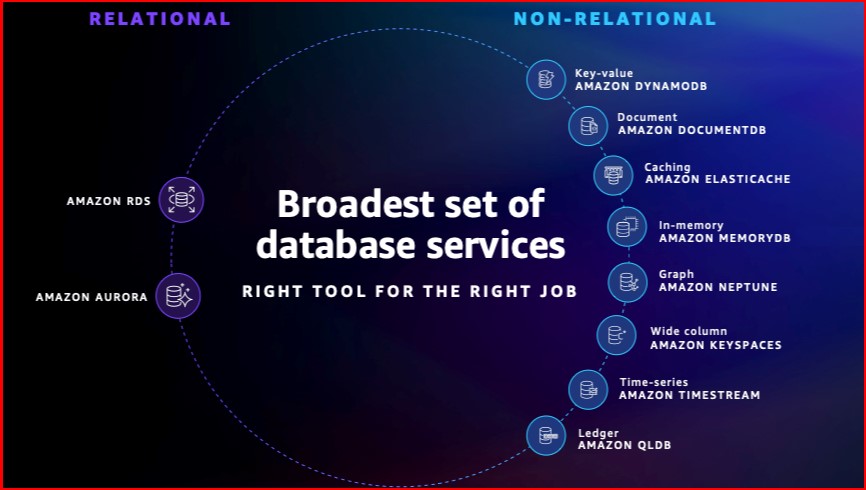Comprehensive Look at Amazon Database Services
 Muhammad Irfan
Muhammad Irfan
An Overview
Amazon Database Services provide a robust suite of solutions to support the diverse data management needs of modern applications. From high-performance relational databases to purpose-built datastores with microsecond latency, AWS offers a secure and reliable foundation for powering data-driven applications and generative AI solutions. With features like serverless options, automatic scaling, and multi-AZ deployments, these services ensure high availability and operational simplicity, allowing businesses to focus on innovation rather than database management. Here’s a quick dive into AWS Database Services, highlighting key features and use cases! 🚀
1. Introduction to Amazon Database Services
AWS Database Services provides a range of managed database solutions that cater to various data types and workloads. This allows users to harness the scalability and performance of AWS without the hassle of database management.🌐
2. Types of Amazon Database Services
2.1 Relational Databases
Amazon RDS (Relational Database Service) Amazon RDS is a managed service that simplifies the setup, operation, and scaling of relational databases in the cloud. It supports a variety of database engines, including Amazon Aurora, PostgreSQL, SQL Server, and MySQL, allowing users to choose the technology that best fits their needs. With features like automated backups, patch management, and read replicas for scalability, Amazon RDS enables users to focus on their applications rather than the heavy lifting of database administration. It offers cost-efficiency and flexibility, making it a popular choice for managing relational databases in the AWS cloud.
Key Features:
Automated backups and patching 🔄
Multi-AZ deployments for high availability 🌍
Read replicas for enhanced performance 📈
2.2 NoSQL Databases
Amazon DynamoDB: It is a fully managed NoSQL database service that provides fast and predictable performance with seamless scalability. Launched in 2012, it allows customers to offload the administrative burdens of operating and scaling distributed databases. DynamoDB supports key-value and document data models, and is designed to provide consistent, single-digit millisecond latency for any scale of workload. It also offers built-in security, backup and restore, and in-memory caching for internet-scale applications. DynamoDB is well-suited for mobile, web, gaming, ad tech, IoT, and many other applications.
Key Features:
Single-digit millisecond response times ⏱️
Built-in security, backup, and restore 🔒
Global tables for cross-region replication 🌐
2.3 In-Memory Databases
Amazon ElastiCache : It is a fully managed in-memory data store and cache service provided by Amazon Web Services (AWS). It supports popular caching engines like Redis OSS and Memcached, offering lightning-fast data retrieval capabilities that enhance the performance of web applications. With features such as microsecond response times, cost-optimized performance, and no capacity management, ElastiCache helps businesses achieve high availability and disaster recovery with a 99.99% uptime SLA. It's an ideal solution for scenarios requiring real-time application data caching, session stores, and leaderboards.
Key Features:
Fully managed in-memory storage 🧠
Automatic failover and backup options 🔄
Support for various data structures 📊
3. Specialized Database Services
3.1 Amazon Aurora
It is a fully managed relational database service that's part of the Amazon Relational Database Service (RDS). It's designed to deliver the speed and reliability of high-end commercial databases with the simplicity and cost-effectiveness of open-source databases. Compatible with MySQL and PostgreSQL, Aurora can offer up to five times the throughput of MySQL and up to three times the throughput of PostgreSQL. It automates standard database tasks such as hardware provisioning, database setup, patching, and backups, allowing users to focus on their applications. With its high-performance storage subsystem, Aurora provides scalability, reliability, and security for database applications.
Key Features:
Up to 5x faster than standard MySQL databases ⚡
Automatic scaling and replication 🔄
Serverless option for on-demand scaling 🌟
3.2 Amazon Redshift
Amazon Redshift is a fully managed, petabyte-scale data warehouse service provided by AWS, designed to handle large scale data sets and database migrations with ease. Utilizing a Massively Parallel Processing (MPP) architecture, it enables fast and cost-effective data analysis using standard SQL and existing business intelligence tools. Redshift is particularly noted for its ability to deliver the best price-performance for data analytics and machine learning applications, making it a popular choice for modernizing data analytics workloads and delivering insights for businesses.
Redshift is a fully managed data warehouse service for analyzing large datasets with SQL.
Key Features:
Columnar storage for efficient querying 📊
Advanced security features 🔒
Integration with AWS services like Glue and S3 🛠️
3.3 Amazon DocumentDB
Amazon DocumentDB is a fully managed document database service that provides MongoDB compatibility. It allows for the storage, retrieval, and management of JSON formatted data. Designed to be highly scalable and secure, Amazon DocumentDB enables developers to build and run applications that require a flexible, scalable NoSQL database with powerful indexing and querying capabilities. With the ability to handle millions of read and write operations per second and petabytes of storage, it's a robust solution for managing large volumes of data efficiently. Moreover, as a managed service, it automates time-consuming administrative tasks such as hardware provisioning, database setup, patching, and backups.
Key Features:
Fully managed with automatic scaling 🌱
Integration with AWS security tools 🔐
High availability with replica sets 📈
4. Migration and Integration Services
4.1 AWS Database Migration Service (DMS)
AWS Database Migration Service (DMS) is a powerful cloud service designed to simplify the migration of databases to AWS. It supports both homogeneous and heterogeneous migrations, ensuring that organizations can move their databases from various sources like Oracle, SQL Server, PostgreSQL, MySQL, and others with minimal downtime. AWS DMS is known for its ability to maintain high availability and provide continuous replication, making it a trusted choice for over a million database migrations globally. With its cost-effective approach, users pay only for the compute resources and log storage used during the migration, making it an efficient solution for businesses of all sizes.
Key Features:
Continuous data replication 🔄
Support for various source and target databases 📊
4.2 AWS Schema Conversion Tool (SCT)
It is a powerful service provided by Amazon Web Services that facilitates the migration of database schemas from one database engine to another. It automates the conversion of source database schema and a majority of the database code objects, including views, stored procedures, and functions, to a format compatible with the target database. This tool simplifies database migrations by providing a detailed assessment of the source database, highlighting actionable items, and offering recommendations for a smooth transition. AWS SCT supports a wide range of source and target databases, making it a versatile solution for organizations looking to modernize their databases or migrate to AWS cloud services.
Key Features:
Supports multiple database engines 🔄
Assessment reports on schema migration 📋
5. Security and Compliance 🔒
AWS provides a comprehensive cloud compliance framework with support for 143 security standards and compliance certifications, including PCI-DSS, HIPAA/HITECH, FedRAMP, GDPR, FIPS 140-2, and NIST 800-171.
The AWS shared responsibility model outlines that while AWS manages the security of the cloud, customers are responsible for security in the cloud, including the guest operating system, application software, and configuration of the AWS-provided firewall.
AWS offers tools like AWS Audit Manager and Amazon GuardDuty to help customers continuously monitor and audit their AWS usage for risk and compliance with regulations and industry standards.
AWS Artifact provides automated compliance reporting, giving on-demand access to over 2,500 security controls to aid in compliance reporting.
Security and compliance in AWS involve third-party validation for thousands of global requirements, which AWS regularly monitors to assist customers in meeting various industry standards.
6. Use Cases
6.1 E-Commerce Applications
E-commerce platforms often use RDS and DynamoDB to manage product catalogs and customer data, benefiting from their scalability and reliability. 🛒
6.2 Analytics and Business Intelligence
Amazon Redshift and Amazon Athena are popular for data warehousing and analytics, enabling insights from large datasets efficiently. 📊
6.3 Mobile and Web Applications
In-memory databases like ElastiCache enhance mobile and web app performance, reducing latency and improving user experience. 📱
7. Conclusion 🌟
Amazon Database Services provide a flexible solution for managing diverse data types. With a plethora of database options and migration tools, AWS empowers businesses to focus on innovation while it handles the complexities. They also offers a comprehensive suite of managed database solutions tailored for various data types and workloads, providing high performance, scalability, and reliability. Key offerings include Amazon RDS for relational databases, DynamoDB for NoSQL, and ElastiCache for in-memory needs, alongside specialized services like Aurora, Redshift, and DocumentDB. These services are complemented by migration tools like AWS Database Migration Service (DMS) and Schema Conversion Tool (SCT) to streamline database transitions to AWS. The platform ensures robust security and compliance, supporting industry standards and certifications, making it ideal for e-commerce, analytics, and mobile/web applications.
#CloudWhistlers #Coudanaires #AWS #DatabaseServices #CloudComputing #DataManagement #BigData #Innovation #AmazonWebServices #DynamoDB #Redshift #ElastiCache
Subscribe to my newsletter
Read articles from Muhammad Irfan directly inside your inbox. Subscribe to the newsletter, and don't miss out.
Written by

Muhammad Irfan
Muhammad Irfan
I am passionate about the transformative power of Linux, DevOps, and cloud technologies. With a background in system administration, I’m on a journey to master cloud infrastructure, automation, and containerization. On my GitHub, you’ll find projects where I explore automation, AWS, CI/CD, and scripting to solve real-world problems. 📚 Current Focus: Enhancing my expertise in Linux systems, AWS, and scripting. Here, I share insights and experiences from my hands-on projects to help and inspire fellow tech enthusiasts.